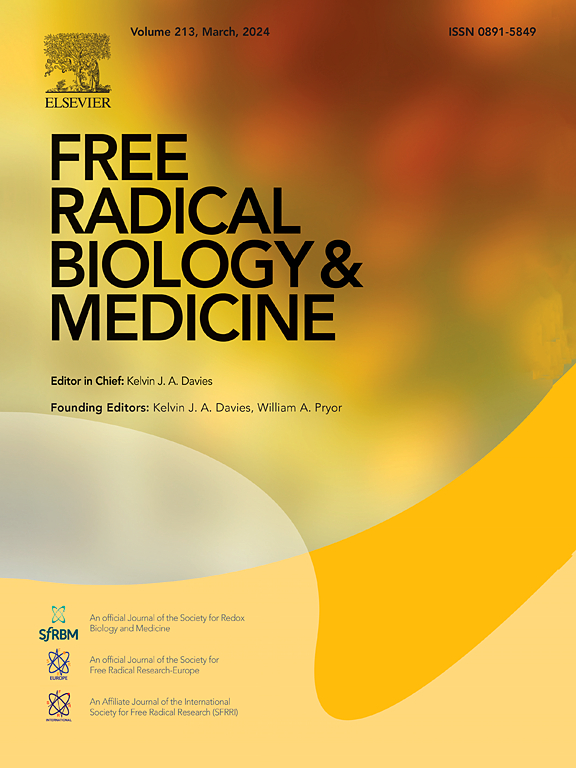NADPH oxidase 4-SH3 domain-containing YSC84-like 1 complex participates liver inflammation and fibrosis
IF 7.1
2区 生物学
Q1 BIOCHEMISTRY & MOLECULAR BIOLOGY
引用次数: 0
Abstract
There is growing evidence that NADPH oxidase 4 (Nox4) in hepatocytes contributes to liver inflammation and fibrosis during the development of metabolic dysfunction-associated steatohepatitis (MASH). However, how Nox4 is regulated and leads to liver pathogenesis is unclear. Our previous studies showed that the cytosolic protein SH3 domain-containing Ysc84-like 1 (SH3YL1) regulates Nox4 activity. Here, we asked whether SH3YL1 also participates in liver inflammation and fibrosis during MASH development. We generated that whole body SH3YL1 knockout (SH3YL1−/−), Nox4 knockout (Nox4−/−) mice, and the hepatocyte-specific SH3YL1 conditional knockout (Alb-Cre/SH3YL1fl/fl) mice were fed a methionine/choline-deficient (MCD) diet to induce liver inflammation and fibrosis in pathogenesis of MASH. Palmitate-stimulated primary SH3YL1-and Nox4-deficient hepatocytes and hepatic stellate cells (HSCs) did not generate H2O2. While the liver of MCD diet-fed wild type (WT) mice demonstrated elevated 3-nitrotyrosine as a protein oxidation and 4-hydroxynonenal adducts as a lipid oxidation and increased liver inflammation, hepatocyte apoptosis, and liver fibrosis, these events were markedly reduced in SH3YL1−/−, Nox4−/−, and Alb-Cre/SH3YL1fl/fl mice. The MCD diet-fed WT mice also showed elevated hepatocyte expression of SH3YL1 protein. Similarly, liver biopsies from MASH patients demonstrated strong hepatocyte SH3YL1 protein expression, whereas hepatocytes from patients with steatosis weakly expressed SH3YL1 and histologically normal patient hepatocytes exhibited very little SH3YL1 expression. The Nox4-SH3YL1 complex in murine hepatocytes elevates their H2O2 production, which promotes the liver inflammation, hepatocyte apoptosis, and liver fibrosis that characterize MASH. This axis may also participate in MASH in humans.

含有ysc84样1复合体的NADPH氧化酶4-SH3结构域参与肝脏炎症和纤维化。
越来越多的证据表明,在代谢功能障碍相关脂肪性肝炎(MASH)的发展过程中,肝细胞中的NADPH氧化酶4 (Nox4)参与肝脏炎症和纤维化。然而,Nox4如何调控并导致肝脏发病机制尚不清楚。我们之前的研究表明含有Ysc84-like 1 (SH3YL1)的胞质蛋白SH3结构域调控Nox4的活性。在这里,我们询问SH3YL1是否也参与了MASH发展过程中的肝脏炎症和纤维化。我们将全身SH3YL1敲除(SH3YL1-/-)、Nox4敲除(Nox4-/-)和肝细胞特异性SH3YL1条件敲除(Alb-Cre/SH3YL1fl/fl)小鼠喂食蛋氨酸/胆碱缺乏(MCD)饮食,诱导肝脏炎症和纤维化。棕榈酸刺激的原代SH3YL1-和nox4缺陷肝细胞和肝星状细胞(hsc)不产生H2O2。MCD饮食喂养的野生型(WT)小鼠的肝脏表现出3-硝基酪氨酸作为蛋白质氧化和4-羟基壬烯醛加合物作为脂质氧化的升高,肝脏炎症、肝细胞凋亡和肝纤维化增加,而这些事件在SH3YL1-/-、Nox4-/-和Alb-Cre/SH3YL1fl/fl小鼠中明显减少。MCD饮食喂养的WT小鼠也显示出肝细胞SH3YL1蛋白表达升高。同样,来自MASH患者的肝活检显示出强烈的SH3YL1蛋白表达,而来自脂肪变性患者的肝细胞弱表达SH3YL1,而组织学正常患者的肝细胞表现出很少的SH3YL1表达。小鼠肝细胞中的Nox4-SH3YL1复合物可提高其H2O2的产生,从而促进肝脏炎症、肝细胞凋亡和肝纤维化,这是MASH的特征。这条轴也可能参与人类的MASH。
本文章由计算机程序翻译,如有差异,请以英文原文为准。
求助全文
约1分钟内获得全文
求助全文
来源期刊

Free Radical Biology and Medicine
医学-内分泌学与代谢
CiteScore
14.00
自引率
4.10%
发文量
850
审稿时长
22 days
期刊介绍:
Free Radical Biology and Medicine is a leading journal in the field of redox biology, which is the study of the role of reactive oxygen species (ROS) and other oxidizing agents in biological systems. The journal serves as a premier forum for publishing innovative and groundbreaking research that explores the redox biology of health and disease, covering a wide range of topics and disciplines. Free Radical Biology and Medicine also commissions Special Issues that highlight recent advances in both basic and clinical research, with a particular emphasis on the mechanisms underlying altered metabolism and redox signaling. These Special Issues aim to provide a focused platform for the latest research in the field, fostering collaboration and knowledge exchange among researchers and clinicians.
 求助内容:
求助内容: 应助结果提醒方式:
应助结果提醒方式:


